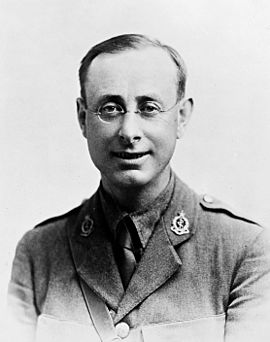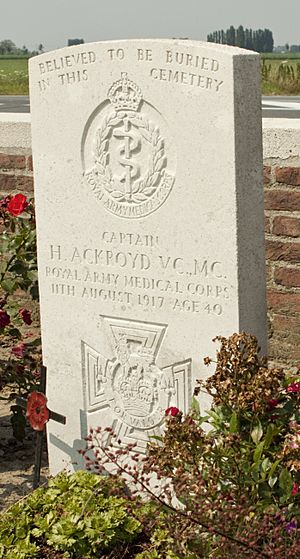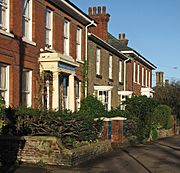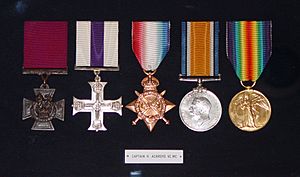Harold Ackroyd facts for kids
Quick facts for kids
Harold Ackroyd
|
|
|---|---|
 |
|
| Born | 18 July 1877 Southport, Lancashire, England |
| Died | 11 August 1917 (aged 40) Passchendaele salient, Belgium |
| Buried |
Birr Cross Roads Cemetery, Zillebeke
|
| Allegiance | United Kingdom |
| Service/ |
British Army |
| Years of service | 1915–1917 |
| Rank | Captain |
| Unit | Royal Army Medical Corps |
| Battles/wars | First World War |
| Awards | Victoria Cross Military Cross |
Harold Ackroyd (born 18 July 1877 – died 11 August 1917) was a brave British doctor and army officer. He received the Victoria Cross, which is the highest award for courage given to soldiers in the British and Commonwealth forces.
He was a captain in the Royal Army Medical Corps during the First World War. He was given the Victoria Cross after he died, for his amazing actions in July and August 1917. This happened during the Battle of Passchendaele.
Contents
Early Life and Education
Harold Ackroyd was born on 18 July 1877 in Southport, England. His father, Edward Ackroyd, was a leader in a railway company.
Harold went to Mintholme College and Shrewsbury School. Later, he studied at Gonville and Caius College, Cambridge. He earned his first degree in 1899. He then traveled and did research before studying medicine at Guy's Hospital in London. He became a doctor in 1904.
Medical Career Before the War
After finishing his studies, Harold worked at Guy's Hospital in London. He also worked at Queen's Hospital in Birmingham. Then he moved to the David Lewis Northern Hospital in Liverpool.
In 1908, he received a special scholarship. This allowed him to do medical research in Cambridge. He worked with famous scientists like Frederick Gowland Hopkins. They wrote several important research papers together.
Military Service in World War I
When the First World War started in 1914, Harold Ackroyd was almost 37. He was married and had three young children. Even so, he decided to join the army.
In February 1915, he became a Temporary Lieutenant in the Royal Army Medical Corps (RAMC). By July 1915, he was sent to France. He worked as a medical officer for the 6th Battalion of the Royal Berkshire Regiment.
Bravery at the Somme
Harold was promoted to temporary captain in 1916. He then fought in the Battle of the Somme in July 1916. He was part of the fierce fighting at Delville Wood.
During this battle, there was heavy shelling and snipers. But Captain Ackroyd stayed calm and helped many wounded soldiers. He saved many lives. Eleven officers praised him in their reports. They even suggested he receive the Victoria Cross. At one point, an exploding shell threw him into the air, but he kept going.
On 19 July 1916, he received the Military Cross for his bravery. The award said:
For great courage and dedication during the fighting. He helped wounded soldiers under heavy fire. When he saw that all our wounded were safe, he went beyond the front line. He brought in both our own and enemy wounded, even though snipers kept shooting at him.
Captain Ackroyd rescued many soldiers from the 1st South African Infantry Brigade. There is a memorial to him at the Fort Beaufort Historical Museum in South Africa. After this, he was very tired and stressed. He was sent home for six weeks to rest.
He felt better by September and asked to return to his regiment in France. He went back in December 1916.
Heroism at Ypres and Final Sacrifice
The 6th Battalion of the Royal Berkshire Regiment fought in the third battle of Ypres. This battle is also known as the Battle of Passchendaele. It began on 31 July 1917.
During this battle, Captain Ackroyd showed incredible bravery. He received 23 separate recommendations for the Victoria Cross. The award stated:
For most outstanding bravery. During recent operations, Captain Ackroyd showed the greatest courage and dedication. He completely ignored danger. He worked constantly for many hours, moving up and down and in front of the line. He cared for the wounded and saved the lives of officers and men. To do this, he had to move across open ground under heavy machine-gun, rifle, and shell fire. He carried a wounded officer to safety under very heavy fire. Another time, he went far in front of our advanced line. He brought in a wounded man under constant sniping and machine-gun fire. His heroism saved many lives. He was a wonderful example of courage, cheerfulness, and determination to the fighting men he was helping. This brave officer was later killed in action.
Captain Ackroyd was killed on 11 August 1917. He was in Jargon Trench in Belgium. A sniper shot him in the head. Private Albert Scriven, his second in command, wrote to Harold's wife. He said that Harold was checking on companies ahead of them to find wounded soldiers when he was shot.
Harold Ackroyd's body was taken away and buried. His headstone at Birr Cross Roads Cemetery in Zillebeke says, "Believed to be buried in this cemetery."
King George V presented his Victoria Cross (number 851) to his wife Mabel and son Stephen. This happened at Buckingham Palace on 26 September 1917.
Family Life
Harold met Mabel Robina Smythe, who was a matron (head nurse) at Strangeways Hospital in Cambridge. They married on 1 August 1908. They lived in Great Shelford, Cambridgeshire. Their children, Ursula (born 1909) and Stephen (born 1912), were born there.
Later, they moved to 46 Kneesworth Street in Royston. Their third child, Anthony (born 1914), was born there.
Memorials
There is a memorial for Harold Ackroyd on the wall of his old house at 46 Kneesworth Street in Royston. His name is also on the Royston war memorial in Melbourn Street. This memorial was revealed on 26 March 1922. A road in Royston, Ackroyd Road, is named after him.
His Medals
Lord Michael Ashcroft bought Harold Ackroyd's medals from his family in 2003. The money from the sale was used to create a special medical scholarship. This scholarship is given every year at Gonville and Caius College, Cambridge, where Harold studied. The college also agreed to hold an annual lecture about science and medicine.
Harold Ackroyd's medals are now on public display. You can see them at the Imperial War Museum in London. Copies of his Victoria Cross, Military Cross, and other war medals are also shown at the RAMC HQ in Millbank, London. There is also a painting of him winning the Victoria Cross there.




